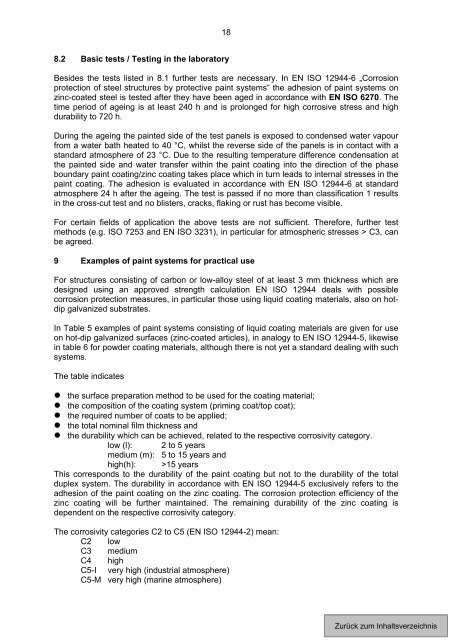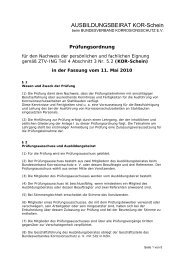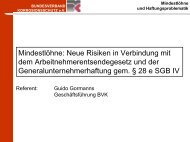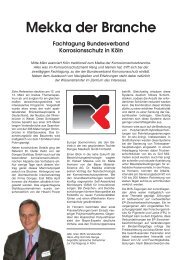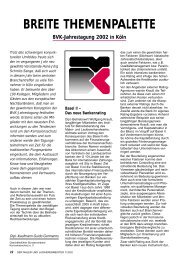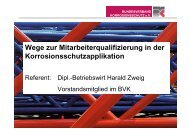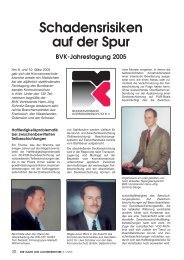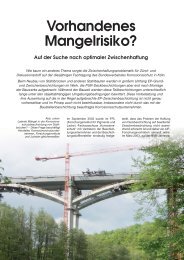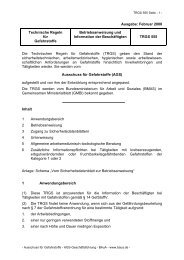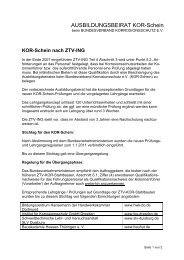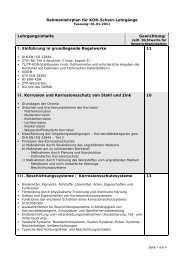Guideline of trade associations - VdL Verband der Lackindustrie e.V.
Guideline of trade associations - VdL Verband der Lackindustrie e.V.
Guideline of trade associations - VdL Verband der Lackindustrie e.V.
Create successful ePaper yourself
Turn your PDF publications into a flip-book with our unique Google optimized e-Paper software.
18<br />
8.2 Basic tests / Testing in the laboratory<br />
Besides the tests listed in 8.1 further tests are necessary. In EN ISO 12944-6 „Corrosion<br />
protection <strong>of</strong> steel structures by protective paint systems“ the adhesion <strong>of</strong> paint systems on<br />
zinc-coated steel is tested after they have been aged in accordance with EN ISO 6270. The<br />
time period <strong>of</strong> ageing is at least 240 h and is prolonged for high corrosive stress and high<br />
durability to 720 h.<br />
During the ageing the painted side <strong>of</strong> the test panels is exposed to condensed water vapour<br />
from a water bath heated to 40 °C, whilst the reverse side <strong>of</strong> the panels is in contact with a<br />
standard atmosphere <strong>of</strong> 23 °C. Due to the resulting temperature difference condensation at<br />
the painted side and water transfer within the paint coating into the direction <strong>of</strong> the phase<br />
boundary paint coating/zinc coating takes place which in turn leads to internal stresses in the<br />
paint coating. The adhesion is evaluated in accordance with EN ISO 12944-6 at standard<br />
atmosphere 24 h after the ageing. The test is passed if no more than classification 1 results<br />
in the cross-cut test and no blisters, cracks, flaking or rust has become visible.<br />
For certain fields <strong>of</strong> application the above tests are not sufficient. Therefore, further test<br />
methods (e.g. ISO 7253 and EN ISO 3231), in particular for atmospheric stresses > C3, can<br />
be agreed.<br />
9 Examples <strong>of</strong> paint systems for practical use<br />
For structures consisting <strong>of</strong> carbon or low-alloy steel <strong>of</strong> at least 3 mm thickness which are<br />
designed using an approved strength calculation EN ISO 12944 deals with possible<br />
corrosion protection measures, in particular those using liquid coating materials, also on hotdip<br />
galvanized substrates.<br />
In Table 5 examples <strong>of</strong> paint systems consisting <strong>of</strong> liquid coating materials are given for use<br />
on hot-dip galvanized surfaces (zinc-coated articles), in analogy to EN ISO 12944-5, likewise<br />
in table 6 for pow<strong>der</strong> coating materials, although there is not yet a standard dealing with such<br />
systems.<br />
The table indicates<br />
� the surface preparation method to be used for the coating material;<br />
� the composition <strong>of</strong> the coating system (priming coat/top coat);<br />
� the required number <strong>of</strong> coats to be applied;<br />
� the total nominal film thickness and<br />
� the durability which can be achieved, related to the respective corrosivity category.<br />
low (l): 2 to 5 years<br />
medium (m): 5 to 15 years and<br />
high(h): >15 years<br />
This corresponds to the durability <strong>of</strong> the paint coating but not to the durability <strong>of</strong> the total<br />
duplex system. The durability in accordance with EN ISO 12944-5 exclusively refers to the<br />
adhesion <strong>of</strong> the paint coating on the zinc coating. The corrosion protection efficiency <strong>of</strong> the<br />
zinc coating will be further maintained. The remaining durability <strong>of</strong> the zinc coating is<br />
dependent on the respective corrosivity category.<br />
The corrosivity categories C2 to C5 (EN ISO 12944-2) mean:<br />
C2 low<br />
C3 medium<br />
C4 high<br />
C5-I very high (industrial atmosphere)<br />
C5-M very high (marine atmosphere)


